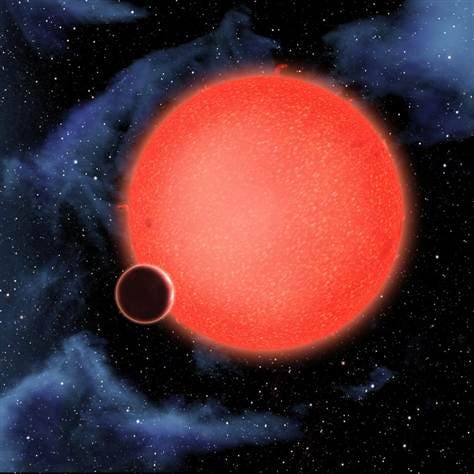
The hunt for the second Earth, a similar life-bearing paradise like our own, rages on, and while no candidate came any close so far, scientists have made some extraordinary discoveries in the process. The latest exciting find is a super-Earth, a planet larger than Earth, but no bigger than Neptune, that represents the first of a new class of exoplanets – a steamy waterworld. Quick, someone call Kevin Costner!
Dubbed, GJ 1214b, the exoplanet is a mere 40 light-years away. It was first discovered in 2009 by ground-based telescopes, and a preliminary report was issued in 2010 by a team of scientists lead by Zachory Berta, from the Harvard Smithsonian Center for Astrophysics. Back then, collected data suggested that GJ 1214b’s atmosphere was likely composed primarily by water, however until recently, they couldn’t make a definitive conclusion.
Even from back then, however, Berta and colleagues knew they came across something extraordinary. Fortunately, they managed to have the Hubble Space Telescope’s wide-field camera take a glimpse in the planet’s direction and study it as it crossed in front of its star. The telescope studied the planet as it was in transit, and thus determined the composition of the planet’s atmosphere based on how it filtered the starlight.
“GJ 1214b is like no planet we know of,” study lead author Zachory Berta of the Harvard-Smithsonian Center for Astrophysics in Cambridge, Mass., said in a statement. “A huge fraction of its mass is made up of water.”
“We’re using Hubble to measure the infrared color of sunset on this world,” Berta said. “The Hubble measurements really tip the balance in favor of a steamy atmosphere.”
An alien world filled with water
The planet is about 2.7 times the Earth’s diameter, however its mass is just seven times higher, resulting in 2 grams per cubic centimeter (g/cc) density. Earth’s density is 5.5 g/cc, while that of water is 1 g/cc. It seems GJ 1214b has a lot more water and a lot less rock than our blue marble – a complete new class of alien planet, one the likes have never been found before.
[RECOMMENDED] Kepler’s hunt for Earth-like planets
It might seem like we’ve found that other life-supporting paradise, however GJ 1214b orbits its red-dwarf star at a distance of 1.2 million miles (2 million kilometers), which results in an estimated surface temperature of about 446 degrees Fahrenheit (230 degrees Celsius). This boiler-planet has no chance of serving life at its surface, covered in a steamy atmosphere. However, deep underwater might be another story. Even on our planet, biologists have found evidence of life lurking right next to hot, underwater geysers.
The high temperatures and high pressures would form exotic materials like ‘hot ice’ or ‘superfluid water,’ substances that are completely alien to our everyday experience,” Berta said.
Still, GJ 1214b sounds extremely interesting and considering it’s relative short distance from Earth, it certainly makes an exciting prospect for follow-up observations by modern, future instruments, like the James Webb Space Telescope, slated for launch in 2018.
The study will be published in a future edition of the Astrophysical Journal.






